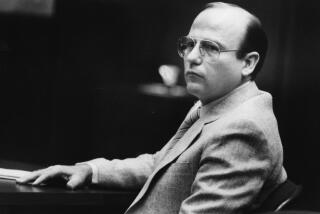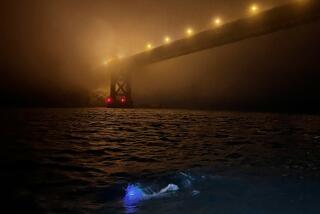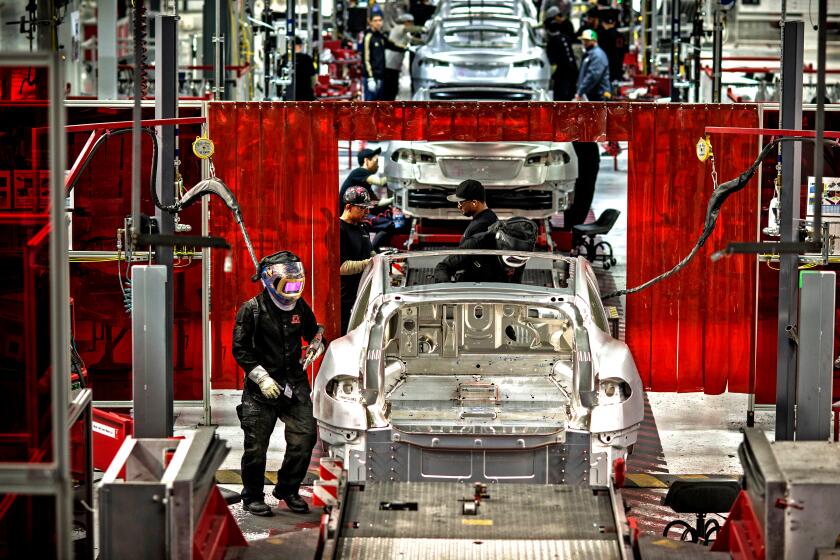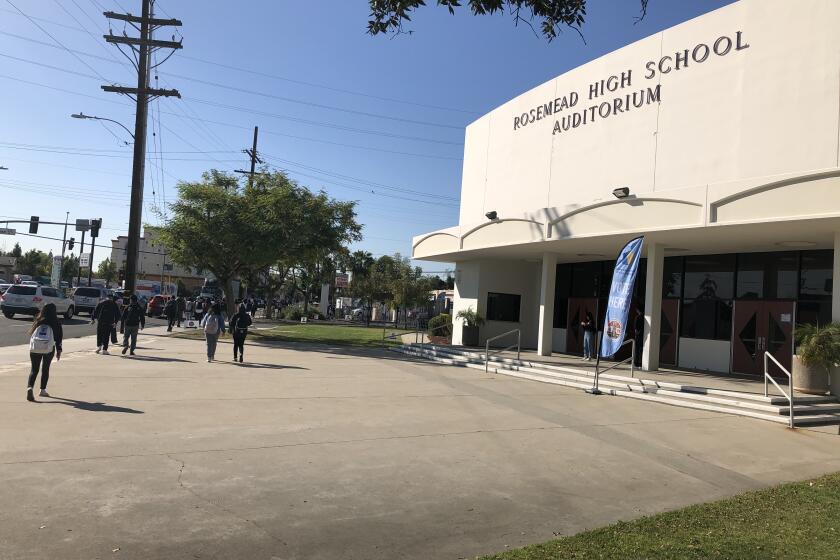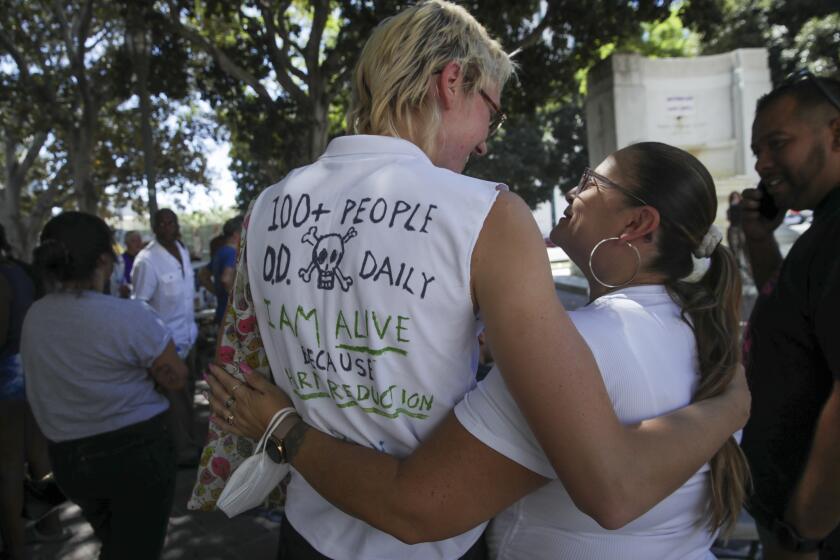Firing of Officer in Taped Beating Is Urged
A Los Angeles police officer who beat a suspect in a car theft with a flashlight in a televised arrest last year should be fired, a police disciplinary panel ruled Friday.
In a emotional session, the three-member panel said Officer John Hatfield used unnecessary force during the June 2004 arrest of Stanley Miller, and recommended that Police Chief William J. Bratton remove Hatfield from his job. Bratton has 10 days to decide.
The arrest, videotaped from above by news crews in helicopters, sparked protests and public demands for Hatfield’s dismissal.
The ruling came after a teary-eyed Hatfield, who had been relieved of duty since the incident, made an ardent plea to keep his job, telling the panel he had learned from the incident.
But board members ruled unanimously that all the blows for which Hatfield faced discipline -- one kick, 11 flashlight blows and five kneeings -- were not sanctioned by policy. They rejected arguments by Hatfield’s defense lawyer that Miller was combative during the arrest and needed to be violently subdued, and said some of Hatfield’s actions could not be viewed as honest mistakes.
The kick and flashlight blows indicated that Hatfield was an out-of-control officer at best, said Capt. Gary Williams, chairman of the panel, reading from a written explanation.
Of even more concern was the end of the incident, Williams said. Hatfield kneed Miller twice, then seemed to consciously take time to reposition himself to deliver three more kneeings, Williams said. That in particular was seen by panel members as “a malicious, intentional act apparently for the purpose of punishment,” Williams said.
Saying such an incident, “blackens the eye of all law enforcement,” Williams said the Los Angeles Police Department could not keep Hatfield on the force.
Dressed in a dark suit and tie, cheeks pale and hands clasped, Hatfield stared straight ahead as Williams read the ruling in a downtown Los Angeles hearing room just after 5 p.m. Friday.
Afterward, Hatfield sat frozen for several seconds before rising to shake hands with the sergeant who had argued his guilt and the panel members who had ruled against him.
The recommendation came at the end of eight grueling days of testimony.
Under Los Angeles City Charter rules, police chiefs cannot summarily fire officers they believe guilty of misconduct. Instead, they must send such cases to disciplinary panels. Those “boards of rights” are an LAPD tradition.
Each board consists of two LAPD commanders and one civilian. The hearings resemble trials in which accused officers are represented by private defense attorneys. The department is represented by specialized officers from an internal affairs unit, who prosecute their fellow officers.
Hatfield, 36, faced just one charge -- using force unnecessarily during Miller’s arrest.
The incident took place early on the morning of June 23, 2004, alongside Compton Creek. Miller had led officers on a high-speed chase out of South Los Angeles, then jumped from the car and ran along the dirt creek bank with several officers on foot in pursuit.
When Miller stopped and put his hands in the air, one officer tackled him. While Miller was on the ground, Hatfield arrived on foot and kicked him, struck him with a flashlight, and kneed him as news cameras rolled overhead.
Protests ensued, though the intensity of the response was tempered by calls for calm from several influential black leaders. They urged followers to await the results of the LAPD’s disciplinary process before passing judgment on the system.
On Friday, one such activist, Najee Ali, praised the ruling. “This helps restore a lot of trust in confidence in the LAPD,” he said.
Before Friday’s hearing, four other officers involved in the incident, Michael O’Conner, Todd Behrens, Peter Bueno and Phillip Watson, were suspended for misconduct.
Officers O’Connor and Behrens were disciplined for failing to recognize the appropriate actions they should have taken during the use of force; Bueno for failing to secure evidence; and Watson for using unnecessary force and unauthorized tactics.
Another officer, David Hale, is scheduled to go before a board of rights in the fall. L.A. County Dist. Atty. Steve Cooley has declined to file charges against any of the officers.
Miller, who has filed a $25-million lawsuit against the city alleging injuries suffered during the arrest, remains jailed on charges of evading arrest, police said. Police say he was not seriously hurt.
Miller didn’t testify in Hatfield’s case, but transcripts of his audiotaped statements to police after the beating were entered as evidence.
Of all those at the scene that June morning, Hatfield drew the strongest public condemnation.
His actions on the video -- particularly the repeated flashlight blows -- were derided by police critics. In response to the incident, LAPD officials say they will replace officers’ metal flashlights with smaller, lighter ones to be issued next year.
Eleven witnesses in all testified during Hatfield’s hearing, including officers involved in the arrest. Hatfield, a large, broad-shouldered officer with a slight double chin, wide eyes and high eyebrows, sat through hours of proceedings, watching intently. The hearing room was packed with his supporters, including several fellow officers.
Sgt. Jason Zabel, associate department advocate, argued the department’s case for a guilty finding.
“Officer Hatfield is not a bad person,” Zabel told the panel in closing arguments. “He didn’t get out of bed that morning and say, I am going to beat someone up. But he was in a long pursuit, then a 200-yard foot pursuit, and he was upset. He was mad -- mad at the suspect.”
Hatfield’s reaction was like a mundane case of road rage, Zabel said, “but for a police officer, it is unacceptable.”
Hatfield’s attorney, Michael P. Stone, countered that his client was reacting to a suspect whom he considered to be very dangerous. Miller, Stone said, had made desperate efforts to escape while driving -- turning off his headlights, speeding through city streets and nearly hitting other motorists. Hatfield thought Miller might have a gun, and that the other officers’ efforts to handcuff him weren’t working, Stone said.
“Maybe in the cold calm reflection of a boardroom [we] can say it was better to do this or that,” Stone said. “But that’s not what we are supposed to do; we are supposed to look through the eyes of the officer at that time.”
During the final stages of the hearing, Hatfield’s parents sat behind him -- his mother bent over, pressing a hand to her brow; his father motionless, arms folded across his chest.
After Williams announced that Hatfield had been found guilty, Hatfield’s mother got up abruptly and hurried out, laying a hand on the medal depicting the Virgin Mary she wore on a chain around her neck.
Stone called several character witnesses to testify to Hatfield’s willingness to redeem himself if he got his job back. Hatfield, who went to the Police Academy in 1997, had earned 38 commendations in his career, and very few complaints, none especially serious.
One character witness, Gerald Sweet, an LAPD psychologist, testified that, based on weekly therapy sessions with Hatfield, he thought the Miller incident was the result of “a collective adrenalin reaction.”
Sweet, who was released from the usual rules of patient confidentiality by Hatfield, said, “Things were moving very fast ... I think [Hatfield] was reacting in a full kind of adrenalin response and was looking to do whatever it took to get a man he believed dangerous into custody.”
Hatfield made a last appeal just before the board announced its final ruling.
Standing before the board, hands gripping either side of a podium, he stood for nearly a minute without speaking, taking deep breaths and pursing his lips. Finally, he asked in a hoarse voice for a break to compose himself.
A few minutes later, he returned, and gripped the podium again.
“I accept full responsibility for my actions on that day,” he said. “I want the board members to know that, at the time, I honestly thought I was doing the right thing.... Nothing I did was with evil or wrongful intent or the intent to inflict unnecessary pain on Mr. Miller.”
But board members disagreed. “This penalty laid heavy on our hearts,” Williams told him. But Hatfield’s actions, he said, “must be looked at in the most significant way.”
More to Read
Start your day right
Sign up for Essential California for news, features and recommendations from the L.A. Times and beyond in your inbox six days a week.
You may occasionally receive promotional content from the Los Angeles Times.
